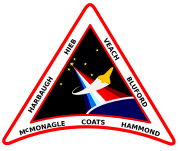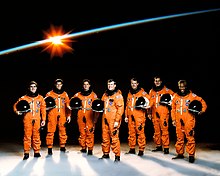
Back STS-39 Arabic STS-39 Bulgarian STS-39 Czech STS-39 Danish STS-39 German استیاس-۳۹ FA STS-39 French STS-39 GL STS-39 HE STS–39 Hungarian
 The Critical ionization velocity (CIV) experiment in Discovery's payload bay | |
| Names | Space Transportation System-39 |
|---|---|
| Mission type | DoD research |
| Operator | NASA |
| COSPAR ID | 1991-031A |
| SATCAT no. | 21242 |
| Mission duration | 8 days, 7 hours, 22 minutes, 23 seconds |
| Distance travelled | 5,584,423 km (3,470,000 mi) |
| Orbits completed | 134 |
| Spacecraft properties | |
| Spacecraft | Space Shuttle Discovery |
| Launch mass | 112,207 kg (247,374 lb) |
| Landing mass | 102,755 kg (226,536 lb) |
| Payload mass | 5,663 kg (12,485 lb) |
| Crew | |
| Crew size | 7 |
| Members | |
| Start of mission | |
| Launch date | April 28, 1991, 11:33:14 UTC (7:33:14 am EDT) |
| Launch site | Kennedy, LC-39A |
| Contractor | Rockwell International |
| End of mission | |
| Landing date | May 6, 1991, 18:55:37 UTC (2:55:37 pm EDT) |
| Landing site | Kennedy, SLF Runway 15 |
| Orbital parameters | |
| Reference system | Geocentric orbit |
| Regime | Low Earth orbit |
| Perigee altitude | 248 km (154 mi) |
| Apogee altitude | 263 km (163 mi) |
| Inclination | 57.01° |
| Period | 89.60 minutes |
| Instruments | |
| |
 STS-39 mission patch  From left: Veach, Coats, Harbaugh, McMonagle, Hammond, Hieb and Bluford | |
STS-39 was the twelfth mission of the NASA Space Shuttle Discovery, and the 40th orbital shuttle mission overall. The primary purpose of the mission was to conduct a variety of payload experiments for the U.S. Department of Defense (DoD).